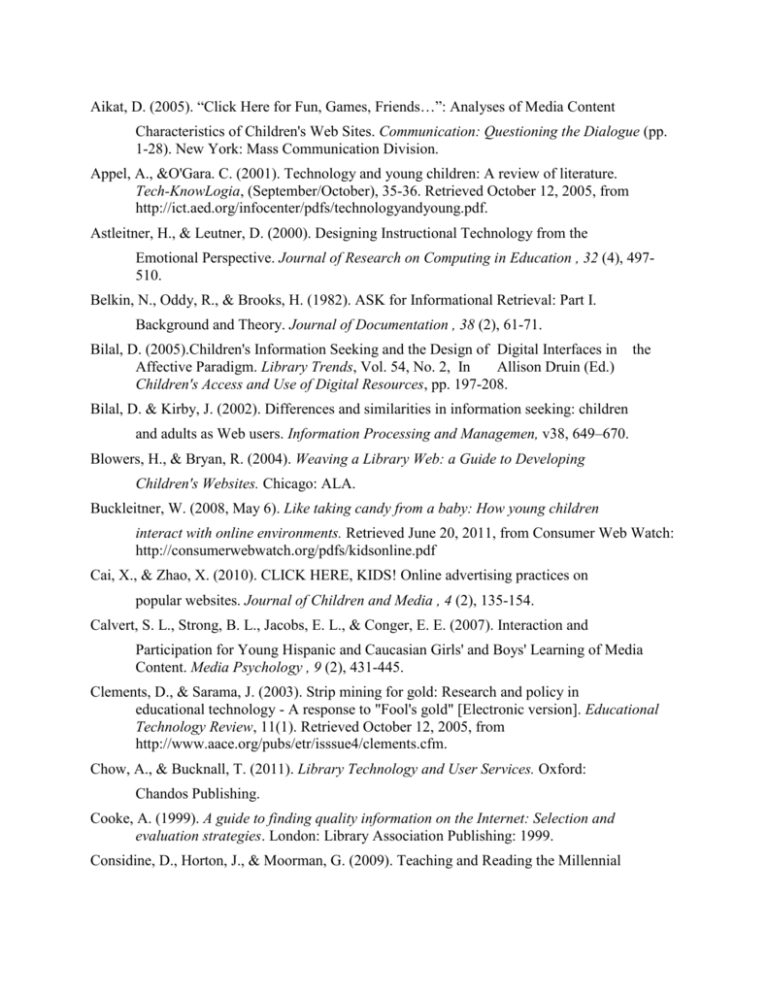Presentation References
advertisement

Aikat, D. (2005). “Click Here for Fun, Games, Friends…”: Analyses of Media Content Characteristics of Children's Web Sites. Communication: Questioning the Dialogue (pp. 1-28). New York: Mass Communication Division. Appel, A., &O'Gara. C. (2001). Technology and young children: A review of literature. Tech-KnowLogia, (September/October), 35-36. Retrieved October 12, 2005, from http://ict.aed.org/infocenter/pdfs/technologyandyoung.pdf. Astleitner, H., & Leutner, D. (2000). Designing Instructional Technology from the Emotional Perspective. Journal of Research on Computing in Education , 32 (4), 497510. Belkin, N., Oddy, R., & Brooks, H. (1982). ASK for Informational Retrieval: Part I. Background and Theory. Journal of Documentation , 38 (2), 61-71. Bilal, D. (2005).Children's Information Seeking and the Design of Digital Interfaces in Affective Paradigm. Library Trends, Vol. 54, No. 2, In Allison Druin (Ed.) Children's Access and Use of Digital Resources, pp. 197-208. the Bilal, D. & Kirby, J. (2002). Differences and similarities in information seeking: children and adults as Web users. Information Processing and Managemen, v38, 649–670. Blowers, H., & Bryan, R. (2004). Weaving a Library Web: a Guide to Developing Children's Websites. Chicago: ALA. Buckleitner, W. (2008, May 6). Like taking candy from a baby: How young children interact with online environments. Retrieved June 20, 2011, from Consumer Web Watch: http://consumerwebwatch.org/pdfs/kidsonline.pdf Cai, X., & Zhao, X. (2010). CLICK HERE, KIDS! Online advertising practices on popular websites. Journal of Children and Media , 4 (2), 135-154. Calvert, S. L., Strong, B. L., Jacobs, E. L., & Conger, E. E. (2007). Interaction and Participation for Young Hispanic and Caucasian Girls' and Boys' Learning of Media Content. Media Psychology , 9 (2), 431-445. Clements, D., & Sarama, J. (2003). Strip mining for gold: Research and policy in educational technology - A response to "Fool's gold" [Electronic version]. Educational Technology Review, 11(1). Retrieved October 12, 2005, from http://www.aace.org/pubs/etr/isssue4/clements.cfm. Chow, A., & Bucknall, T. (2011). Library Technology and User Services. Oxford: Chandos Publishing. Cooke, A. (1999). A guide to finding quality information on the Internet: Selection and evaluation strategies. London: Library Association Publishing: 1999. Considine, D., Horton, J., & Moorman, G. (2009). Teaching and Reading the Millennial Generation Through Media Literacy. Journal of Adolescent & Adult Literacy , 52 (6), 471–481. Cooper, L. Z. (2005). Deveiopmentaily Appropriate Digital Environments for Young Children. Library Trends , 54 (2), 286-302. Cooper, L. Z. (2005). Developmentally Appropriate Digital Environments for Young Children. Library Trends , 54 (2), 286-302. Davidson, J., & Wright, J. (1994). The potential of the microcomputer in the early childhood classroom. I n J.L. Wright & D. D. Shade (Eds.), Young Children: Active learners in a technological age (pp. 77-92). Washington, DC: National Association for the Edtication of Young Children. Deng, L., & Poole, M. S. (2010). Affect in Web Interfaces: A Study of the Impacts of Web Page Visual Complexity and Order. MIS Quarterly , 34 (4), 711-730. DiMichele, P. (2007, April 23). University of Houston – Prospective Student Usability Testing: Results and Recommendations Memorandum. Retrieved June 2, 2009, http://www.uh.edu/evolvinguh/documents/UH_usabilityMemo.pdf. from Druin, A. (2002). The role of children in the design of new technology. Behaviour & Information Technology , 21 (1), 1-25. Druin, A., Bederson, B., Boltman, A., Miura, A., Knotts-Callahan, D., & Platt, M. (1999). Children as our technology design partners. In A. Druin (Ed.), The of Children's Technology (pp. 51-72). San Francisco: Morgan Kaufmann. Design Dubroy, M. (2010). Building Virtual Spaces for Children in the Digital Branch. The Australian Library Journal , 211-223. Fidel, R., Davies, R. K., Douglass, M. H., Holder, J. K., Hopkins, C. J., Kushner, E. J., Miyagishima, B. K., & Toney, C. D. (1999). A Visit to the Information Mall: Web Searching Behavior of High School Students. Journal of the American Society for Information Science, 50(1), 24-37. Harding, J., Szakacs, J., & Parry, B. (2009). Children playing and learning in an online environment: a review of previous research and an examination of six current web sites. Young Consumers , 10 (1), 17-34. Haugland, S. (2000). Computers and young children. ERICDigest, March 2000, EDOPS-00-4. Retrieved May 17, 2005, from Eric Clearinghouse on Elementary and Early Childhood Education. Huitt, W., & Hummel, J. (2003). Piaget's theory of cognitive development. Retrieved June 13, 2011, from Educational Psychology Interactive: http://www.edpsycinteractive.org/topics/cogsys/piaget.html Internet World Stats. (2010, June 30). INTERNET USAGE STATISTICS. Retrieved April 14, 2011, from Internet World Stats: http://www.internetworldstats.com/stats.htm Kuhlthau, C. C. (1991). Inside the Search Process: Information Seeking from the User’s Perspective. Journal of the American Society for Information Science , 42 (5), 361-371. Large, A., & Beheshti, J. (2005). Interface Design, Web Portals, and Children. Library Trends , 54 (2), 318-342. Large, A., Beheshti, J., & Rahman, T. (2002). Design Criteria for Children’s Web Portals: The Users Speak Out. Journal of the American Society for Information Science and Technology , 53 (2), 79-94. Large, A., Beheshti, J., Clement, I., Tabatabae, N., & Yin Tarn, M. T. (2009). Visualizing a Hierarchical Taxonomy in a Children's Web Portal. The Canadian Journal of Information and Library Science , 255-282. Lin, C. (2007). Organizational Website Design as a Rhetorical Situation. IEEE Transactions on Professional Communication, 50, 35-44. Margaryan, A., Littlejohn, A., & Vojt, G. (2011). Are digital natives a myth or reality? University students’ use of digital technologies. Computers & Education , 56 (2), 429– 440. Milligan, C., & Murdock, M. (1996). Testing with Kids & Teens at IOMEGA. Interactions, 3(5), 51-57. National Association for the Education of Young Children (NAEYC). (1996). Technology and young children—Ages 3 through 8 [Position statement]. Washington, DC: NAEYC. Retrieved November 15, 2011, from http://www.naeyc.org/about/positions/PSTECH98.asp. National School Boards Association. (2007). Creating and connecting: Research and guidelines on online social and educational networking. Retrieved June 23, 2008, from www.nsba.org/SecondaryMenu/TLN/CreatingandConnecting.aspx. Nielsen, J., & Loranger, H. (2006). Prioritizing Web Usability. Berkeley: New Riders. Nielsen, J. (2005, January 31). Usability of Websites for Teenagers. Jakob Nielsen’s Alertbox. Retrieved June 2, 2009, from http://www.useit.com/alertbox/teenagers.html Prensky, M. (2009). H. Sapiens Digital: From Digital Immigrants and Digital Natives to Digital Wisdom. Innovate. Retrieved November 15, 2011, from http://innovateonline.info/pdf/vol5_issue3/H._Sapiens_Digital From_Digital_Immigrants_and_Digital_Natives_to_Digital_Wisdom.pdf Prensky, M. (2008). Young minds, fast times: The twenty-first-century digital learner. Retrieved November 15, 2011, from www.edutopia.org/ikid-digital-learner-technology2008 Prensky, M. (2008). Backup Education? Too many teachers see education as preparing kids for the past, not the future. Educational Technology, Vol 48 No 1, Jan-Feb 2008. Retrieved on November 16, 2011 from http://www.marcprensky.com/writing/PrenskyBackup_Education-EdTech-1-08.pdf Prensky, M. (2001). Digital natives, digital immigrants. Retrieved July 5, 2006, from www.marcprensky.com/writing/Prensky%20%20Digital%20Natives,%20Digital%20Im migrants%20-%20Part1.pdf Rose, M., Rose, G. M., & Blodgett, J. G. (2009). The Effects of Interface Design and Age on Children’s Information Processing of Web Sites. Psychology & Marketing , 26 (1), 121. Scaife, M., & Rogers, Y. (1999). Kids as informants: Telling us what we didn’t know or confirming what we knew already? In A. Druin (Ed.), The design of children’s technology (pp. 27–50). San Francisco: Morgan Kaufmann. Spink, A., Danby, S., Mallan, K., & Butler, C. (2010). Exploring young children’s web searching and technoliteracy. Journal of Documentation , 66 (2), 191-206. Strommen, E. F., Revelle, G. L., Medoff, L. L., & Razavi, S. (1996). Slow and steady wins the race? Three-year-old children and pointing device use. Behaviour and Information Technology , 15 (1), 57-64. Sullivan, T., Norris, C., Peet, M., & Soloway, E. (2000). When Kids Use the Web: A Naturalistic Comparison of Children’s Navigation Behavior and Subjective Preferences on Two WWW Sites. Retrieved June 2, 2009, from http://www.pantos.org/ts/papers/wkutw. Taxen, G., Druin, A., Fast, C. and Kjellin, M. (2001), KidStory: a technology design partnership with children, Behaviour and Information Technology, Vol. 20 No. 2, pp. 119-25. US Census Bureau. (2009). Appendix Table A. Households With a Computer and Internet Use: 1984 to 2009. Washington: US Census Bureau. US Census Bureau. (2003). Computer and Internet Use in the United States: 2003. Washington: US Census Bureau. Van Scoter,J., Ellis, D., & Railsback, J. (2001). Child development: What research says about technology and child development. In Technology in early childhood education: Finding the balance. Portland, OR: Northwest Regional Educational Laboratory. Retrieved November 14, 2011, from http://www.nwrel.org/request/june01/textonly.html. Wallace, R.M., Kupperman, J., Krajcik, J., & Soloway, E. (2000). Science on the Web: Students online in a sixth-grade classroom. Journal of the Learning Sciences, 9(1), 75–104.




